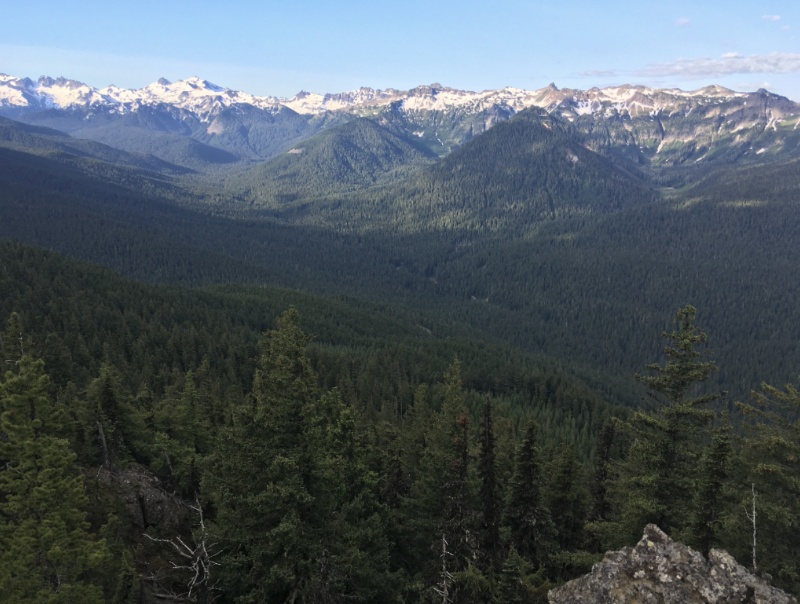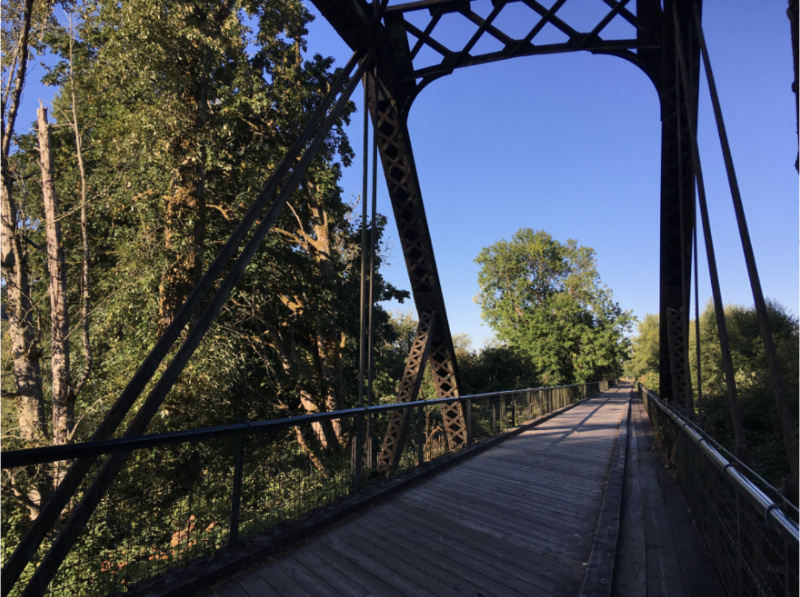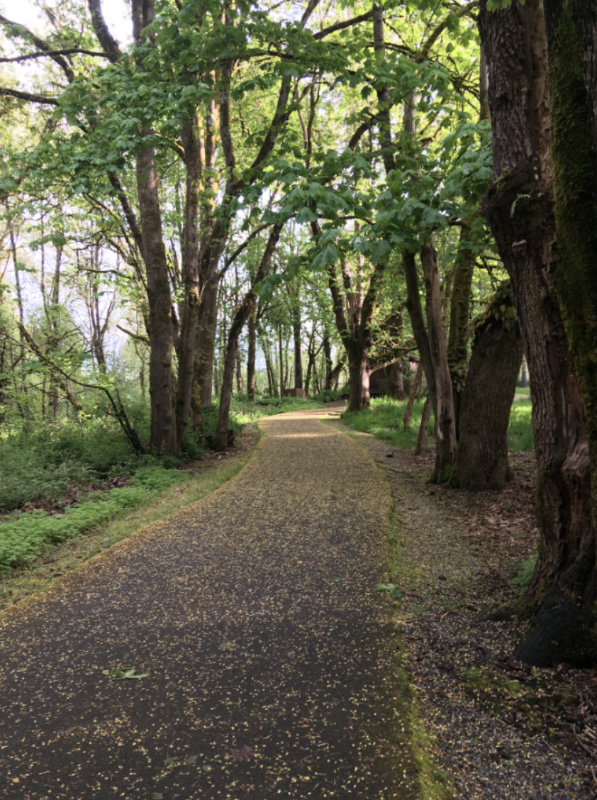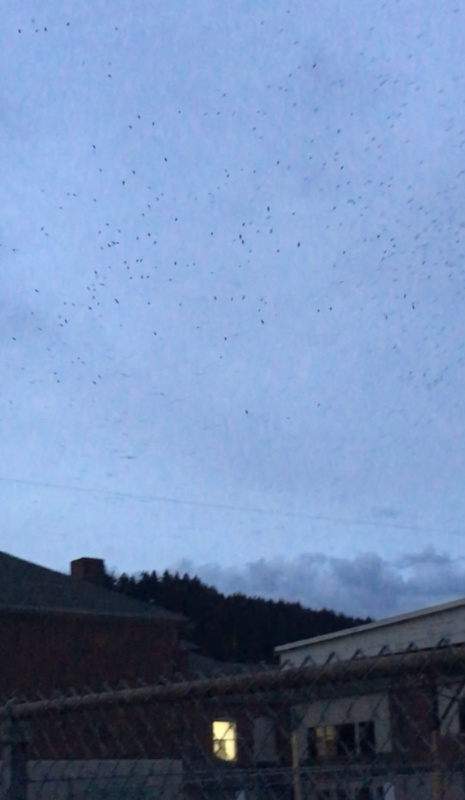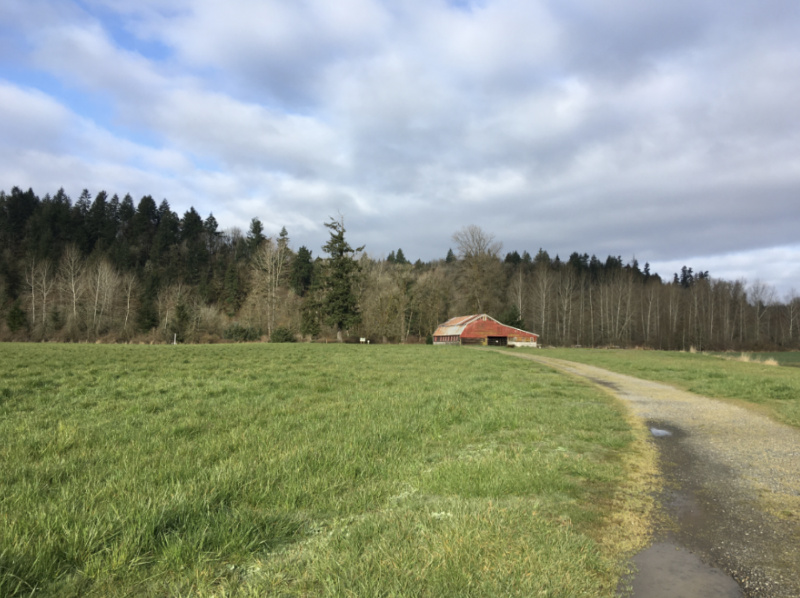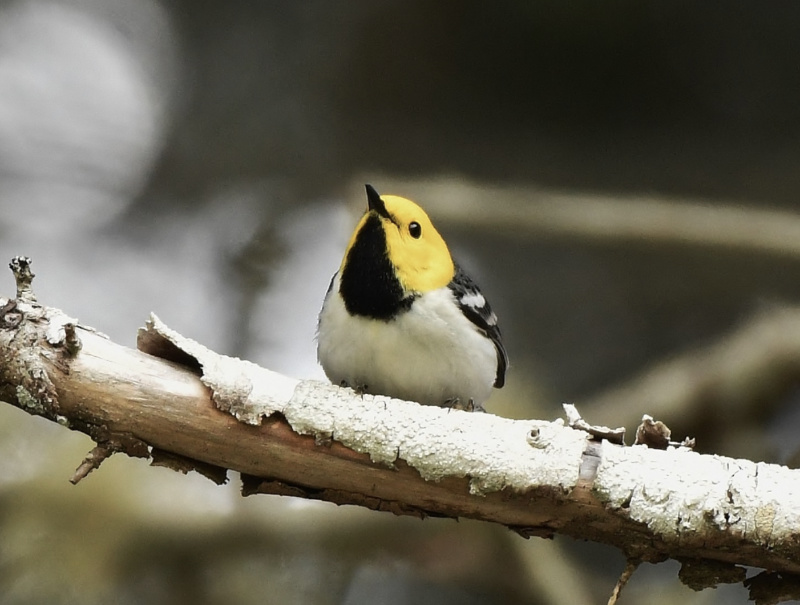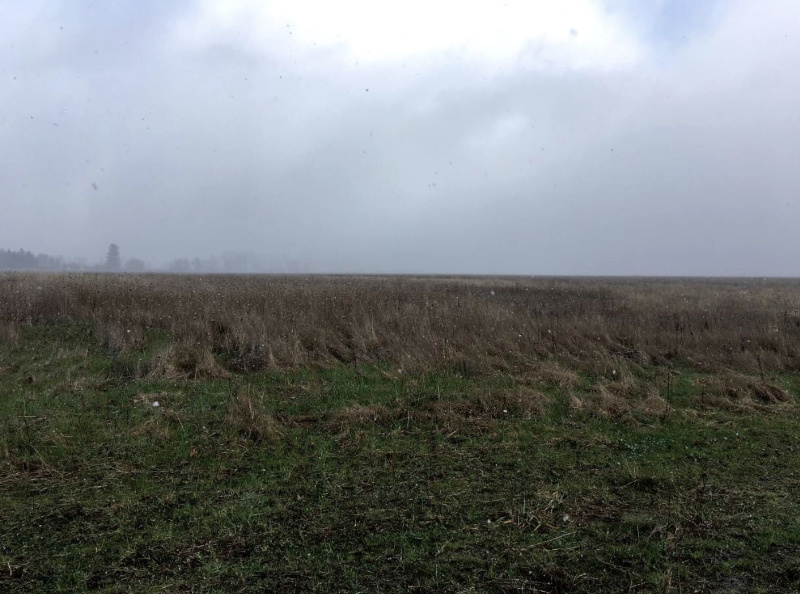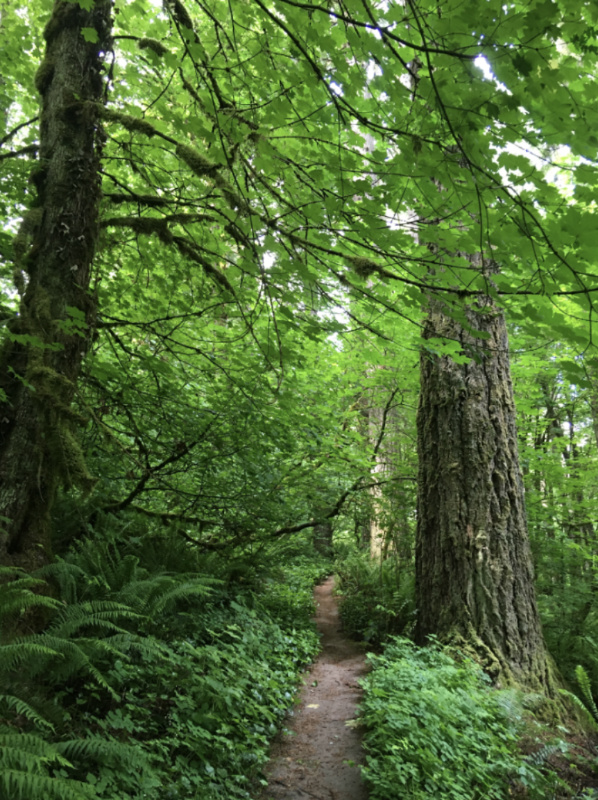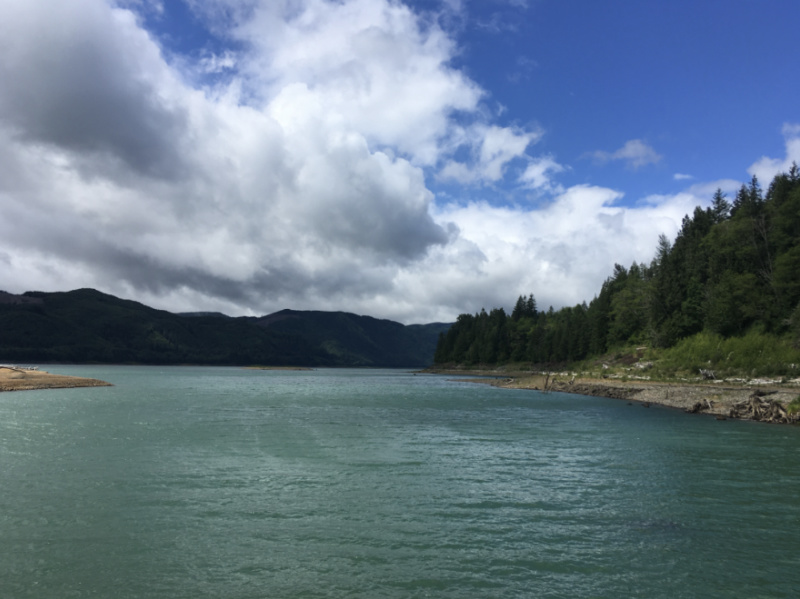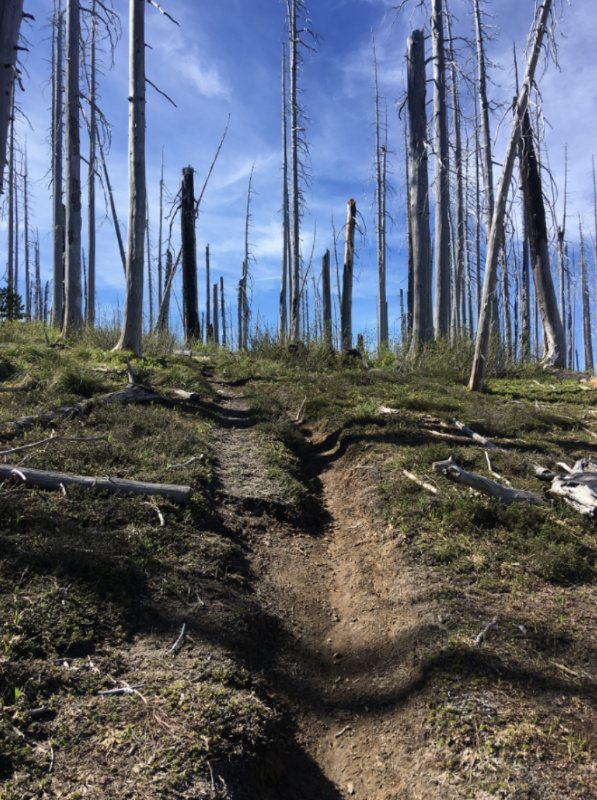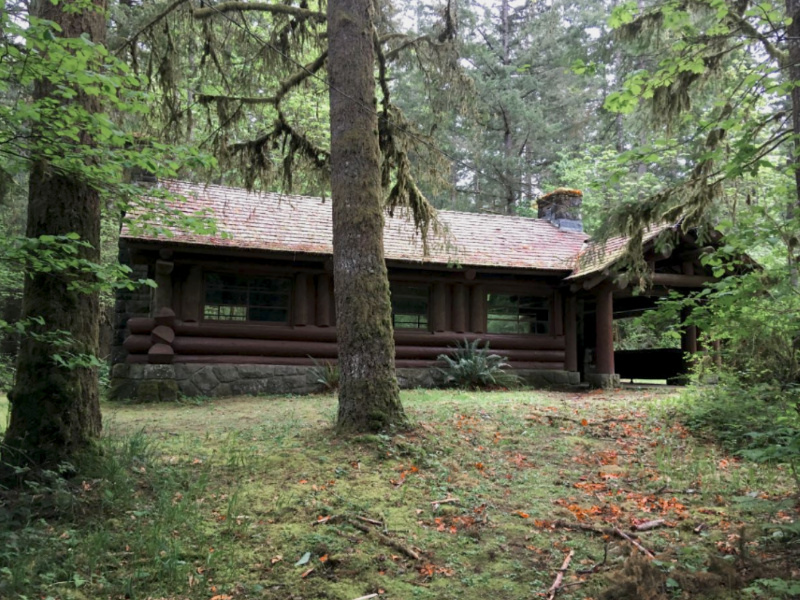By Rachel Hudson
Lewis County is widely overlooked by the multitudes of birders in the “big cities” up north. It’s very rural, has few main roads, and is quite out-of-the-way for city folk. There are few large parks and fewer big attractions. It is a land-locked county, with the majority of it encompassing farmland or various tree farms. However, birds still live in Lewis County, and in great abundance. The secret is knowing where to search.
In Lewis County, there aren’t really any one-stop-shop locations for birds that would constitute a full day’s trip. Instead, most locations are small and scattered, with each one only taking a few hours at most to explore. Here, I have listed all of my favorite locations, attractions, and pit stops.
Willapa Hills State Park Trail Perhaps the single most overlooked gem in the county, this state park is a tremendous masterpiece that spans 56 miles from Chehalis in Lewis County out to South Bend in Pacific County. It is a long trail that was once a railroad, so it is flat and easy to traverse. Parts of it are paved, parts are gravel, and parts are long boardwalks or concrete bridges over beautiful rivers and streams. It traverses many, many habitats throughout its length, and is host to well over 100 species of birds in the Lewis portion alone. Reliable highlights include nesting Bullock’s Orioles and Yellow Warblers at the Chehalis entrance, Western Tanagers throughout, large numbers of Canvasbacks in winter at the Chehalis entrance, Lazuli Buntings in summer at the Shorey Road crossing, White-throated Sparrows in fall and winter at the Chehalis entrance, masses of ducks and geese, Trumpeter Swans in fields, ponds, and wetlands throughout, and so much more. Rare to uncommon birds that have been found along the trail (just by me alone) include Say’s Phoebe in late winter, Black Phoebe in winter, Bank Swallows (far out on the trail by a presumed colony on the river) in summer, Snow and White-fronted Geese in fall/winter, Peregrine Falcons in fall/winter, and Western Meadowlarks and American Pipits in fall/winter.
There are many access points all along the trail. Some are no more than gravel pullouts barely large enough for one vehicle, while others are full parking lots; these will be Discover Pass lots. The major parking lot at the trail’s beginning in Chehalis does have a pit toilet, as well as the parking area in Adna. Obviously, this is an out-and-back trail, so the distance covered is entirely up to the people traversing it. You can walk, jog, ride your bike, or ride a horse along the trail, but no motorized vehicles are allowed. Dogs are allowed but must be kept on a leash at ALL times, not only because of safety, but also because the trail passes through private farms and properties, where livestock and both working and pet dogs will be using the trail. The rivers along the trail are also very dangerous, and several people have drowned in them; the water is deceptively cold and fast-moving. DO NOT venture off the trail. Because this park spans so much ground, there are often closures due to natural hazards, washouts, or trail improvements; the most comprehensive and consistently up-to-date map of everything you need to know about the trail can be found here.
Airport Road Area, Chehalis This is a personal favorite of mine and isn’t much more than a gravel trail along a raised hill/dike around the local tiny airport. Airport Road is unique in that it offers unparalleled views of distant habitats, due to its raised nature. The airport staff are friendly to birders and have been known to grant special permissions for land use to birders in the past. That being said, PLEASE stay on the trail and do not enter the airport area itself under any circumstances. We want to keep the trail open to the public and keep up our good relations with the staff. This counts as a city park and is thus free to access. There are no restrooms or other facilities here, so keep that in mind.
This trail does have a name (Airport Levee Trail), but for birders, the trail isn’t the entirety of the attraction. Airport Road, to me, includes the road, the Levee Trail, and one area of residential roads adjacent to it, as well as visible parts of a golf course. Giving rise to over 100 species of birds here, as well, this little area is a treat year-round. It’s hard to measure distance when including the little off-shoots that should be checked for specific species, but the entire area is no more than 3.5 miles across. A typical birding route would begin by car at NW Shoreline Drive, where there are several small, hidden ponds that are always good for Wood Ducks in winter and the occasional Black Phoebe. Following the short drive from Shoreline onto NW Cedar Street, NW Brace Street, and then onto NW Florida Avenue, you will be driving slowly along narrow roads with many houses; at the end of NW Florida Ave, there is another pond, and that can be checked from the car for any interesting ducks. NW Florida intersects with NW Airport Road, where the Levee Trail begins; you should see a small parking area for it right in front of you at the intersection (be careful; it can be hard to see oncoming traffic at that intersection). I usually don’t park at that spot, but if you’re interested in checking the lower area of the airport for Northern Harriers, or the golf course for Green Herons or other interesting waterbirds, there would probably be the best place to start.
Driving north along NW Airport Road, not far past the golf course where the speed limit increases and farmland begins, you will find a gravel pullout on the right. Park there if you want to check the airport runways for Western Meadowlarks (year-round) or the fields for rare shorebirds (migration/winter). This area has hosted many shorebirds that are almost impossible to find anywhere else in Lewis County, including Whimbrel, Marbled Godwit, Dunlin, Long-billed Dowitcher, and Least Sandpiper. The seasonal ponds in the west fields will always have shorebirds in fall/winter, but it can be hard to see over the grasses; when Peregrines or Eagles scare them up, then would be a good time to spot them in the air. This area is also host to massive flocks of wintering ducks, with the highlights being huge numbers of American and Eurasian Wigeon. There are hybrids of the two, as well, so watch out! See how many you can find! If a rare duck is to be spotted in Chehalis, this would be one of the top spots to find one.
From here, you can walk north until you reach the curve; just north of that curve is another set of hidden ponds. There, the more shy birds will be lurking, such as Blue-winged Teal, Greater Yellowlegs, American Coot, and Ring-necked Duck. This is also where I found the county’s first and only Snow Bunting. American Pipits will be everywhere but hidden, in the fields around here in winter. You can either walk or drive on from there, still heading north, to the next pullout on the right near the end of the road. This pullout is reliable for Black Phoebe in winter (though they can be seen/heard anywhere in the Airport Road area); walk up to the trail and turn right, heading toward the small building. From anywhere around this spot, you can see into a large pond, where Black Phoebes will be calling and flycatching from low perches, mixed duck flocks will be everywhere, and passerines such as Lincoln’s Sparrows, kinglets, Song Sparrows, American Goldfinches, and more will be active in the dense brush below in winter. Here, in recent years, a seasonal pond or two in the fields north of the road host more ducks, and staggering numbers of thousands of Cackling Geese. Now would be a great time to brush up on your Cackling Goose subspecies skills! Many are Minima, with plenty of Taverner’s mixed in. Common Canada Geese will join the numbers, making it clear how diminutive the Cacklers are. In winter, rare birds such as Brant and Northern Shrike have been found here, and other rarities will be reported from this area year-round
From the pullout, you can either drive or walk the rest of the trail (which becomes paved and follows a fast road) to check out the fields and ponds farther north, up as far as you like (but I usually go no further than the freeway overpass). The fields here can host flocks of gulls and geese that graze, and they also have large ponds worth checking year-round. I tend to avoid walking from here, just because of the traffic noise from the adjacent road and freeway. In all, the Airport Road area is a surprisingly fun tour and is easy to access.
Fort Borst Park Borst Park in Centralia is perhaps the most widely known and highly visited park in the area. It is a medium-sized city park, free and open to the public year-round. It has picnic areas, playgrounds, off-leash dog parks, full restrooms and kitchens, and plentiful trails. A fun attraction on the opposite side of the park’s entrance is the Borst Home, for anyone who’s interested in local history. The story of Mary and Joseph Borst, who settled here in the mid-1800s, is rich and exciting, and occasionally the Borst Home (their multi-story house, carefully preserved and well-kept to look as it did over a hundred years ago) is open to the public, typically only during special events (such as the 4th of July). You are free to explore all around outside the house year-round, however.
The gardens and arboretum surrounding the house are another big attraction for nature lovers, as well as for birds. Red-breasted Sapsuckers will sometimes visit the old orchard trees, and Lesser Goldfinches have frequented the garden off and on over the past half-decade. Pileated Woodpeckers sometimes visit the old snags over the riverbank behind the home, and Bushtits build their elaborate sock nests in the evergreens nearby. Seeing all the bright flowers in the gardens by the Borst home in summer is thrilling (and the hummingbirds love them, as well). Warblers are abundant here in spring; watch for Yellow, Yellow-rumped, Orange-crowned, Black-throated Gray, Wilson’s, and even the occasional Nashville Warblers in the mixed deciduous forest surrounding the trails between the house, the river, and the dog park. Bewick’s Wrens are abundant here, as are American Robins, both Chickadees and Dark-eyed Juncos. Northern Flickers of both types (and hybrids) can be seen here in the winter. Brown Creepers will coat the tall evergreens throughout the park year-round, calling frequently. In winter, check mixed flocks of birds for Townsend’s Warblers, as they love the tops of the evergreens and will sometimes come down to the main pond for a drink or bath.
The pond, Borst Lake, is always worth checking out. Great Blue Herons and Double-crested Cormorants are usually on the pond (with Bald Eagles watching nearby). Sometimes fun gulls, such as Iceland or Glaucous Gulls, will rest on the pond in the enormous gull flocks that form here in winter, all of which are very tame and offer exceptional views and opportunities to study the various gull species of Washington, as well as hybrid identification. Pied-billed Grebes also love the pond, as do Ring-necked Ducks, Bufflehead, and a multitude of both wild and domestic Mallard and Mallard-adjacent ducks.
There are many winding trails that make their way down from the main park to the river; just keep an eye on your surroundings (there are homeless encampments near the river), and have fun. Most people enjoy fishing from the riverbank, and for birders, the riverbank can offer views of fishing Bald Eagles, Osprey, swallows, Belted Kingfishers, and the occasional Spotted Sandpiper. Osprey always nest on the light towers in the sports fields on the north side of the Borst home, and in the past, Purple Martins have also nested there, though I haven’t been out to look for any in recent years, and did not see any the last few times I checked.
In all, Borst Park offers a fun little experience with more to see and do than just a trail through the woods.
Chehalis Vaux’s Swifts This one is an ever-changing, but very personal, one for me. All the information you could ever want about Vaux’s Swifts can be found on the website created and maintained by my Project Coordinator, Larry Schwitters, so I won’t describe it all here. Long story short, Chehalis has been an important stopover site for Vaux’s Swifts for many years now, and I have been the on-the-ground counter for them since I first found one of their roost sites outside my house years ago. Here’s a video I took of them doing their thing here in Chehalis, and it pretty much sums up why they’re so incredible.
There are some very challenging things to note about the Swifts here, however. They do not have one single roost site that they use year after year, as they do at Portland Chapman, JBLM, Monroe Wagner, and Selleck. In Chehalis, they have used more roosts than I can count at this point, perhaps over 20. I have to figure out, on my own, where exactly they roost each night during both spring and fall migration, which is not an easy task. Because of the ever-changing nature of their roosts, as well as constant building demolitions/remodels which destroy their roosts, there is no single reliable site for them, but I will be able to guide anyone searching every spring and fall migration (typically April-May and August-September).
Discovery Trail, Centralia This is a very quiet trail that is sometimes closed in winter due to high water levels on the river adjacent to the trail. Located off Goodrich Road in Centralia, you park for free at the Centralia Wastewater Treatment Plant and walk down the road’s end to the trail entrance. This is an area best explored in cooler weather, as it is not shaded pretty much throughout its length, and there aren’t many interesting summer birds there, anyway. In fall through winter, however, the mixed waterbird flocks in the seasonal pond are always fun, hosting Eurasian Wigeon, Green-winged Teal, various shorebirds (Black-bellied Plovers have frequently been found there), Trumpeter Swans, both Goldeneyes and more. Geese and gulls are also all over the fields and buildings here, with exciting opportunities to find unusual species hidden in the ranks. In spring, Rufous Hummingbirds zoom around by the river, nesting Bald Eagles will chatter and twitter, and Ruby-crowned Kinglets will sing nonstop.
The trail is easy but is another out-and-back. All told you’ll likely walk about 3.5 miles if you follow both sides of the T-shaped trail to their ends and back. There is a toilet there, but it is often locked, so be advised. There isn’t much to see here specifically, but it is quiet, secluded, and easy to walk. Plus, the farmland here is beautiful, offering a great scenic view on a nice day.
Doty-Dryad Cemetery This spot, far out in Doty off of Highway 6, is a must-stop location in late spring and summer for just one single species: Hermit Warbler. They are reliable there to a fault, however, sometimes playback of a Hermit Warbler song will be needed in order to actually see one. They will inevitably be singing at the upper left corner of the tiny cemetery, where you can park your car on the path (NOT on the grass). Turn right onto Chandler Road from Highway 6 (just past Rainbow Falls State Park), and enter the cemetery by turning right into it from Chandler Road, driving up the hill, turning left, and stopping at the left turn by the trees that will take you back out to Chandler when you’re done birding. I have personally found Hermit Warblers at various locations along Chandler Road, but the cemetery is the only publicly accessible spot to try for them. Beware Townsend’s x Hermit hybrids! Hybrids are also there, and will be nearly identical to pure Hermits in almost every way but plumage; their feathers will often adopt some aspect of a Townsend’s Warbler, such as yellow instead of white on their breast, streaky heads, or black stripes on their flanks.
Pleasant Valley Road This one is mostly just a drive-by check, but there are 3 very small pullouts (only one can fit more than one vehicle, and it probably only holds 2 at best safely). The intersection of Twin Oaks and Pleasant Valley Roads (access by turning left onto Old Highway 603 from Highway 6, then taking the first right onto Twin Oaks and following it to the first road on the left: Pleasant Valley). Here is a winter-specific spot that is critical locally on Lewis County’s Christmas Bird Count, and is a target location for anyone wanting very specific birds for their Lewis County lists. This has recently become a notable spot for Short-eared Owls in winter as they hunt the distant grasslands (a scope is necessary), and both Tundra and Trumpeter Swans will be in the far-off seasonal marshes, alongside thousands of ducks. Lincoln’s Sparrows will be easily found in the vegetation by the road, and at night farther along Pleasant Valley and near the evergreen forest, various owls such as Great Horned and Northern Saw-whet Owls can be heard. Park in the first gravel pullout on the left by the lone oak tree to get a chance to view hunting Short-eared Owls, Northern Harriers, Red-tailed Hawks, and the occasional Rough-legged Hawk. Bald Eagles of all ages will also join the Red-tails in dotting distant trees as they stalk the abundant waterfowl there. Again: a scope is required here. The flocks of birds will be about one mile out from the pullout, and you’ll just have to hope that the raptors will move in closer (most often in the evening or early morning) to allow a solid ID. Elk (and many deer) are also common here, so be extremely careful on the roads!
Seminary Hill Seminary Hill in Centralia is a quaint, peaceful park outside the hustle and bustle of Downtown. It is a moderately challenging hike, because the hill is quite steep and can be very slippery with mud after rain. There are lots of segments of trail that have wooden slats in the ground for stairs, and the rest is just bare soil. It is a maze of trails, but that makes it fun to explore; it isn’t very big, but has a lot of walking potential, and can be fun for those seeking more of a natural experience.
This is a relatively old-growth forest (not too old, but older than most of the other areas nearby), with very dense, tall evergreens and thick underbrush. Here, any skulky forest bird can be found, such as Swainson’s Thrush, Pacific Wren, Wilson’s Warbler, Hairy Woodpecker, and Spotted Towhee. The species diversity here is rather poor, but that’s just due to its small size and singular habitat type. You can find many small woodland flower species here, and in spring, a few more colorful passerines such as Evening Grosbeaks, Black-headed Grosbeaks, Western Tanagers, and Wilson’s Warblers can be seen. It isn’t frequently birded, so there’s always a chance of finding something exciting!
East Lewis County Rather than a single location, East County, to me, means any of a host of locations all along Highway 12 up to White Pass. Each of these locations can have its own fun adventures, but few have specialties; they’re all worth a look, though!
- Riffe Lake East End From Highway 12, turn right onto Kosmos Road a little ways before Glenoma, take the first hard left onto Champion Haul Road, and turn right at its intersection with Glenoma Road. Park in the little designated area before the gate at the end of the road. Here, follow the road past the gate on foot as far as you want to go; it ends at the lake itself, so you’ll have to turn around and head back anyway. I’m not sure if a Discover Pass is required; I think it may be. Anyway, the scenery here is beautiful and fun to experience, and you’ll likely have the place to yourself. It’s only a one-mile walk from the intersection of the road to the edge of the lake, so it’s not far, nor is it challenging. Here, there can be any number of interesting or rare birds coming through in mixed flocks on migration, so check the trees around the intersection for those. Later in early summer, Lazuli Buntings and Western Meadowlarks will be singing out in the low trees near the lake, and Bank Swallows will be a sought-after species here, soaring over the tiny water channels in the tall grasses.
- Scenic Viewpoints in the Mountains Obviously, they’re fun for the scenery. But in the summer, most of these viewpoints will have singing Hermit Thrushes, Pacific Wrens, and the occasional Townsend’s Solitaire or Canada Jay passing through. Red Crossbills will frequent these pullouts for odd gravel-licking purposes, perhaps also to glean salt from the roadside. Pine Siskins and Yellow-rumped Warblers are everywhere up in the mountains here. Viewpoints include Mt. Rainier—Goat Rocks, Palisades, Lava Falls, and more.
- Peters Road Wetlands Turn right off Highway 12 onto Peters Road, just before Randle; not far down, you’ll see wide open fields with varying amounts of water hidden in them. There may or may not be a pullout on the left side of the road; last I saw, there were some reflectors installed to deter pulling over there, but I also seem to remember people flattened them so they can still park there anyway. Regardless, this area is host to some interesting waterbirds at various times of the year and has also held such rarities as Gray Catbird, Indigo Bunting, and Yellow-breasted Chat.
- Taidnapam Park I haven’t been here in a long time, and have only visited it twice, so I am not familiar with it at all. However, I will never forget the many Nashville Warblers I saw in spring there once and the up-close Rough-winged Swallows on the riverbank. I remember it being beautiful, so it would be worth visiting. I do not know if there are fees/passes required or not.
- Riffe and Mayfield Lakes Both have hosted rare/weird ocean species, such as a variety of terns, loons, grebes, and a recent American White Pelican, however, I haven’t personally birded them much, and don’t have any specific places to go other than what eBird would tell you.
White Pass Area White Pass, Knuppenburg Lake, and NF-1284 are all worthy places to stop here. Cassin’s Finches and interesting subspecies of Fox Sparrow can be seen sometimes at White Pass (stay on the Lewis County side of it!), Common Ravens are everywhere, and I know there are rare woodpeckers out there, but the only one I’ve ever been lucky enough to see is an American Three-toed Woodpecker. Black-backed can also be seen out there; I can’t nail them down personally, though. Barrow’s Goldeneyes breed on Knuppenburg Lake. And NF-1284 is a mildly treacherous forest road (4-wheel drive vehicles with high clearance are required) that leads to my favorite treasure in this region, Sand Lake Trail. It’s not a good idea to take anyone who isn’t an experienced hiker/wilderness camper here, however, as it’s the steepest trail I’ve ever been on (800-foot elevation gain over just 1,800 feet), and has many trail hazards, such as fallen trees, boulders, and more. However, at the summit, Mountain and Western Bluebirds both breed at an old burn zone here, the only place in the county to find both in one place reliably. Canada Jays, Clark’s Nutcrackers, Olive-sided Flycatchers, and Townsend’s Solitaires are common here. See my article on our DIY Field Trip page as well.
Other Spots It is impossible for me to adequately summarize all the smaller spots I know of, as most of them are merely a single spot on the side of a road, but these areas all deserve an honorable mention:
- Lewis and Clark State Park Plenty of old-growth evergreens and all the Pacific Wrens you could ever want. It says it’s closed 95% of the time, but last I checked with the rangers, they’re okay with parking at the station and just walking in.
- Rainbow Falls State Park Nothing too exciting here other than campgrounds and more old evergreen forests, however, it is noteworthy that if you pull over on the side of Highway 6, by the river, across from the main area of the park, you stand a good chance at finding American Dipper working the rocks in the river there in summer or when the water is low. You can also see Dipper from a few places along the rivers of the Willapa Hills Trail, as well.
- Napavine Community Park Rather small, very overgrown in summer (the grass can be upwards of 6 feet tall), and a swamp in winter (tall waterproof boots are required); but it always has fun stuff, especially in the trees near locals’ bird feeders. Evening Grosbeaks can be heard there, and Band-tailed Pigeons are common. Fun wildlife such as young Rough-skinned Newts, Long-tailed Weasels, and various species of moths and butterflies are abundant. Park at the back of the skate park in Napavine, by the playground; to the right of the playground is a trail that leads back into the woods there.
- Econo Lodge Pond, Chehalis Rather a misnomer now, as the Econo Lodge has changed ownership and is a different hotel now: Oyo, but the little pond on the south end of it (park in the gravel there, off SW Interstate Ave) has interesting waterfowl sometimes. Look for Cinnamon Teal in early summer, and random shorebirds/waterfowl in winter.
- Brick Wagner Park and Hayes Lake, Centralia If you look at Centralia on a map, you will notice two huge ponds right off the freeway. These are Hayes Lake and Plummer Lake, and they can have fun waterfowl in winter. I found a Surf Scoter there not too long ago; incredibly rare inland for our land-locked county. To view Hayes Lake (and all of its American Coots through winter), park at the back of Dairy Queen. For Plummer Lake (which often has Common Mergansers and other ducks), keep going past Dairy Queen on Harrison Avenue, keep right at the Y past the river, and turn right at the first intersection there onto Tilley Avenue (the farthest south of the two roads there; so, it’s a right, then keep left immediately after that). Follow that road to its end, and you’ll be in a tiny park (Brick Wagner) overlooking the lake.
- Rice and Labree Roads, Chehalis Always worth driving along these and checking for interesting birds in the fields and on the fences. Swans and gulls, sometimes other waterfowl, can be out there. Lesser Black-backed Gull was seen by me and many others in the gull flock on Rice Road. Rice Road also goes by Stan Hedwall Park; nothing noteworthy there that I’ve ever found, though.
- Schaefer County Park, Centralia A cute little park with a very beautiful bridge leading into a densely forested area with loop trails within. I’ve heard Red-eyed Vireos there in the past, but only rarely. Good woodpecker spot, and I’ve seen nesting Black-headed Grosbeak there. Not much overall.
- Centralia Steam Plant A challenging area to bird, but worth it if you can do so safely, following all the rules and abandoning ship if any officials ask you to. Don’t stay in one spot too long. The safest spot to bird is a wide area on the right side of the main road, Hanaford Valley Road, below the massive power lines. Use a scope to check the ponds behind the train from where you parked. Don’t stay longer than necessary. This is the only reliable spot in the county for Ruddy Ducks. You can continue down Hanaford a ways past the plant, but it’s not recommended to go too far before you’ll be met with a spot that might be closed, making it hard to turn around. The Steam Plant itself is host to many amazing species, but it is not open to the public, and I’ve only gotten to bird it by accompanying a friend who worked there, following all mine safety protocols and using the mine’s vehicles. Do the best you can from the main road, and do not enter or block any driveway. Yellow-breasted Chat is regular here, as well, in brushy areas past the plant itself.


